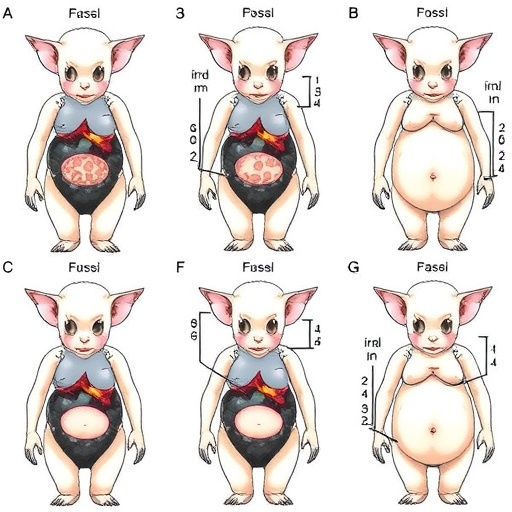Early Protein Restriction Impacts Adipose Development Across Generations – bioengineer.org

Report on the Intergenerational Effects of Early Life Protein Restriction and Implications for Sustainable Development Goals
1.0 Introduction
A recent study conducted by Alonso-García, Suárez-Vega, and Fonseca has revealed significant intergenerational effects of early-life protein restriction on adipose tissue development. Utilizing a sheep model and advanced transcriptomic analysis, the research demonstrates that nutritional deficits during critical developmental windows can induce “metabolic programming,” altering gene expression in offspring and subsequent generations. These findings have profound implications for public health, agricultural science, and the achievement of several key United Nations Sustainable Development Goals (SDGs), particularly SDG 2 (Zero Hunger) and SDG 3 (Good Health and Well-being).
2.0 Research Overview and Key Findings
2.1 Methodology
The study employed a comprehensive transcriptomic analysis of sheep, an organism with metabolic processes physiologically similar to humans. Researchers examined gene expression patterns in adipose tissue of offspring from mothers subjected to protein-restricted diets during gestation. The analysis extended to subsequent generations to understand the transgenerational transmission of these effects.
2.2 Principal Findings
- Altered Gene Expression: Offspring of protein-restricted mothers exhibited significant alterations in genes regulating adipogenesis, including those involved in lipid metabolism, inflammation, and cellular differentiation.
- Metabolic Programming: The results provide strong evidence for metabolic programming, where early-life nutritional conditions pre-program an individual’s metabolic trajectory. This can create a predisposition to metabolic disorders such as obesity, particularly in nutrient-rich environments later in life.
- Intergenerational Impact: The study confirmed that these developmental and metabolic alterations can be propagated across generations, highlighting the long-term consequences of maternal malnutrition.
3.0 Alignment with Sustainable Development Goals (SDGs)
3.1 Contribution to SDG 3: Good Health and Well-being
The research directly supports the objectives of SDG 3, which aims to ensure healthy lives and promote well-being for all at all ages. The findings are particularly relevant to Target 3.4, which seeks to reduce premature mortality from non-communicable diseases (NCDs) like obesity and metabolic syndrome.
- Preventing Non-Communicable Diseases: By identifying the developmental origins of metabolic disease, this research provides a scientific basis for preventative public health strategies. It underscores that ensuring adequate maternal nutrition is a critical intervention for reducing the future burden of obesity and related NCDs.
- Maternal and Child Health: The study reinforces the importance of prenatal and early-life nutrition as a cornerstone of lifelong health. It calls for a reevaluation of dietary guidelines for pregnant women to mitigate the risks of adverse metabolic programming in their children.
3.2 Contribution to SDG 2: Zero Hunger
While SDG 2 focuses on ending hunger, it also explicitly targets ending all forms of malnutrition (Target 2.2). This research highlights that addressing malnutrition is not merely about caloric intake but also about nutritional quality, such as adequate protein.
- Addressing Malnutrition Quality: The study demonstrates that protein deficiency, a form of malnutrition, has lasting negative health consequences. This informs policies aimed at improving the quality and composition of diets for vulnerable populations, especially pregnant women and young children.
- Sustainable Agricultural Practices: The findings have direct implications for livestock management and food production systems. The research advocates for reformulating animal feed to prioritize the long-term metabolic health of offspring over maximizing short-term growth rates. This shift supports more resilient and sustainable animal husbandry, contributing to a stable and healthy food supply.
4.0 Broader Implications and Future Directions
4.1 Policy and Public Health
The intergenerational nature of these findings necessitates a long-term perspective in public health policy. Creating awareness and implementing nutritional support programs for expectant mothers can serve as a powerful, cost-effective strategy for improving population health and advancing global health targets.
4.2 Future Research
Further investigation is required to fully understand the epigenetic mechanisms mediating the transgenerational transmission of these traits. An integrative approach combining transcriptomics, metabolomics, and phenotyping is recommended to build a holistic model of how nutrition influences biological systems across generations.
5.0 Conclusion
The study by Alonso-García et al. provides compelling evidence that early-life protein restriction has profound and lasting effects on metabolic health across generations. By illuminating the biological mechanisms of metabolic programming, this research offers critical insights for shaping effective public health and agricultural policies. Its alignment with SDG 3 (Good Health and Well-being) and SDG 2 (Zero Hunger) underscores the urgent need to prioritize maternal and early-life nutrition as a fundamental strategy for building a healthier and more sustainable future.
Analysis of Sustainable Development Goals in the Article
-
Which SDGs are addressed or connected to the issues highlighted in the article?
The article primarily addresses issues related to the following Sustainable Development Goals (SDGs):
- SDG 2: Zero Hunger: The article’s core focus on the quality of nutrition, specifically “early life protein restriction,” directly relates to the goal of ending all forms of malnutrition. It moves beyond simple food availability to emphasize the critical role of specific nutrients (like protein) for healthy development. Furthermore, its discussion on reconsidering “livestock feed formulations” connects to sustainable agricultural practices aimed at improving food quality and animal health.
- SDG 3: Good Health and Well-being: This is the most prominent SDG in the article. The research links early nutritional deficits to long-term health outcomes, such as an “increased risk for obesity and related conditions” and “metabolic disorders.” The article explicitly discusses preventing non-communicable diseases and highlights how understanding “metabolic programming” can inform public health strategies and “dietary guidelines for pregnant women” to promote lifelong health across generations.
- SDG 12: Responsible Consumption and Production: The article touches upon this goal by advocating for a “paradigm shift in managing animal health.” It suggests that agricultural practices should focus not just on “maximizing growth rates” but on “ensuring better long-term health and metabolic resilience in their offspring.” This reflects a move towards more sustainable production patterns in animal husbandry, considering the long-term quality and health implications of production methods.
-
What specific targets under those SDGs can be identified based on the article’s content?
Based on the article’s content, the following specific targets can be identified:
- Target 2.2: By 2030, end all forms of malnutrition, including achieving, by 2025, the internationally agreed targets on stunting and wasting in children under 5 years of age, and address the nutritional needs of adolescent girls, pregnant and lactating women and older persons. The article directly supports this target by investigating the profound, intergenerational effects of “early life protein restriction,” a specific form of malnutrition. It emphasizes the importance of nutrition for pregnant mothers and its long-term impact on offspring, aligning with the target’s focus on addressing the nutritional needs of pregnant women to prevent future health problems.
- Target 3.4: By 2030, reduce by one third premature mortality from non-communicable diseases through prevention and treatment and promote mental health and well-being. The research is fundamentally about prevention. It identifies early-life nutrition as a key factor in “metabolic programming,” which can “predispose the offspring to various metabolic disorders later in life,” including obesity and chronic diseases. The article states that creating awareness about nutrition during this period could be a “key strategy for reducing the prevalence of obesity and associated diseases in future generations,” directly contributing to the prevention of non-communicable diseases.
- Target 12.2: By 2030, achieve the sustainable management and efficient use of natural resources. The article’s call to reconsider “livestock feed formulations” to promote “long-term health and metabolic resilience” instead of solely focusing on maximizing growth rates is an example of promoting more sustainable and efficient agricultural production. Healthier livestock are a more sustainable resource, potentially requiring fewer interventions and leading to higher quality outputs over the long term.
-
Are there any indicators mentioned or implied in the article that can be used to measure progress towards the identified targets?
The article does not mention official SDG indicators but implies several measurable factors that could be used to track progress:
- Prevalence of obesity and metabolic disorders: The article’s central theme is the risk of obesity and related conditions due to early nutritional deficits. A reduction in the prevalence of these non-communicable diseases in the population would be a direct indicator of progress towards Target 3.4.
- Changes in dietary guidelines and public awareness: The article suggests that its findings should question “current dietary guidelines for pregnant women” and that “creating awareness around nutritional intake” is a key strategy. The revision of national dietary guidelines and surveys measuring public understanding of early-life nutrition would serve as indicators of policy and societal response.
- Alterations in agricultural practices: The call for a “paradigm shift” in animal husbandry implies that changes in “livestock feed formulations” can be measured. Tracking the adoption of feed that prioritizes long-term health and resilience over simple growth maximization would be a clear indicator of progress towards more sustainable production (Target 12.2).
- Gene expression profiles: On a scientific level, the article uses “transcriptomic analysis” to identify “alterations in gene expression related to adipogenesis.” These molecular-level measurements can serve as early-warning indicators to assess the impact of nutritional interventions on metabolic health long before clinical symptoms appear.
-
Create a table with three columns titled ‘SDGs, Targets and Indicators” to present the findings from analyzing the article. In this table, list the Sustainable Development Goals (SDGs), their corresponding targets, and the specific indicators identified in the article.
SDGs Targets Indicators (Implied in the Article) SDG 2: Zero Hunger Target 2.2: End all forms of malnutrition. - Data on nutritional intake (specifically protein) during pregnancy.
- Gene expression profiles related to metabolic programming in offspring.
SDG 3: Good Health and Well-being Target 3.4: Reduce premature mortality from non-communicable diseases through prevention. - Prevalence of obesity, metabolic syndrome, and related chronic diseases in the population.
- Adoption and content of national dietary guidelines for pregnant women.
- Public awareness levels regarding the importance of early-life nutrition.
SDG 12: Responsible Consumption and Production Target 12.2: Achieve the sustainable management and efficient use of natural resources. - Changes in livestock feed formulations to prioritize long-term health.
- Metrics measuring the metabolic health and resilience of livestock offspring.
Source: bioengineer.org
What is Your Reaction?
 Like
0
Like
0
 Dislike
0
Dislike
0
 Love
0
Love
0
 Funny
0
Funny
0
 Angry
0
Angry
0
 Sad
0
Sad
0
 Wow
0
Wow
0















































/environment-climate-change-and-health-(ech)/water-sanitation-hygiene-and-health-(wsh)/landfill-tuvalu-36092.tmb-1200v.jpg?sfvrsn=5c21fe40_1#)


.jpg.webp?itok=0ZsAnae9#)























